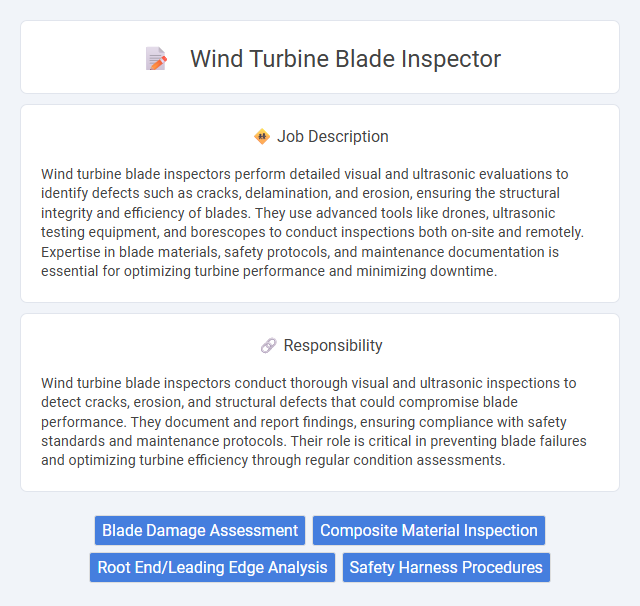
Wind turbine blade inspectors perform detailed visual and ultrasonic evaluations to identify defects such as cracks, delamination, and erosion, ensuring the structural integrity and efficiency of blades. They use advanced tools like drones, ultrasonic testing equipment, and borescopes to conduct inspections both on-site and remotely. Expertise in blade materials, safety protocols, and maintenance documentation is essential for optimizing turbine performance and minimizing downtime.
Candidates with strong attention to detail and a tolerance for working at heights are likely suitable for a wind turbine blade inspector role. Physical fitness and a willingness to work in varying weather conditions will probably enhance job performance. Those prone to vertigo or claustrophobia may find the position less compatible with their condition.
Qualification
A Wind Turbine Blade Inspector requires a strong background in mechanical or civil engineering, often combined with certifications in Non-Destructive Testing (NDT) or blade inspection techniques. Proficiency in safety protocols, climbing skills, and experience with advanced inspection tools such as drones and ultrasonic equipment are essential. Candidates must possess keen attention to detail and the ability to identify structural defects to ensure the integrity and efficiency of wind turbine blades.
Responsibility
Wind turbine blade inspectors conduct thorough visual and ultrasonic inspections to detect cracks, erosion, and structural defects that could compromise blade performance. They document and report findings, ensuring compliance with safety standards and maintenance protocols. Their role is critical in preventing blade failures and optimizing turbine efficiency through regular condition assessments.
Benefit
A wind turbine blade inspector job likely offers benefits such as competitive salaries and opportunities for career advancement within the renewable energy sector. Employees may benefit from hands-on experience with cutting-edge technology and contribute to sustainable energy initiatives. Health and safety benefits might also be common due to the physical nature and potential hazards involved in blade inspections.
Challenge
Wind turbine blade inspectors likely face the challenge of navigating complex and hazardous environments while ensuring thorough and accurate assessments. The probability of encountering varying weather conditions and height-related risks may require specialized safety training and sharp attention to detail. Inspectors must probably adapt quickly to technological advancements and evolving inspection techniques to maintain blade integrity and prevent turbine failures.
Career Advancement
Wind turbine blade inspector careers offer substantial growth opportunities in the renewable energy sector, with pathways leading to senior inspection roles, quality assurance management, and technical specialist positions. Proficiency in non-destructive testing techniques and advanced safety protocols enhances job prospects and facilitates progression to supervisory or project coordination roles. Continuous professional development through certifications such as Level II UT or MT, alongside experience in blade maintenance and repair, significantly accelerates career advancement in this field.
Key Terms
Blade Damage Assessment
Wind turbine blade inspectors specialize in detailed blade damage assessment to identify cracks, erosion, delamination, and lightning strike damages that compromise blade integrity and performance. Using advanced technologies such as ultrasonic testing, thermography, and drones equipped with high-resolution cameras, inspectors provide precise evaluations that guide maintenance and repair decisions. Their assessments ensure turbine blades operate efficiently, minimizing downtime and extending asset lifespan in wind energy projects.
Composite Material Inspection
Wind turbine blade inspectors specializing in composite material inspection evaluate the integrity and performance of fiberglass, carbon fiber, and epoxy resin components in turbine blades. They employ advanced non-destructive testing techniques such as ultrasonic testing, thermography, and visual inspections to detect delaminations, cracks, and voids that could compromise blade durability. Thorough inspections ensure early defect identification to maintain optimal turbine efficiency and prevent costly failures.
Root End/Leading Edge Analysis
Wind turbine blade inspectors specializing in Root End and Leading Edge Analysis play a critical role in ensuring turbine efficiency and safety by identifying cracks, erosion, and delamination in these high-stress areas using advanced ultrasonic and visual inspection techniques. Root End inspections focus on detecting fatigue damage where blades attach to the hub, while Leading Edge analysis targets impact damage from environmental factors like hail and debris. Precise defect characterization and reporting enable timely maintenance, reducing downtime and extending blade lifespan in renewable energy operations.
Safety Harness Procedures
Wind turbine blade inspectors follow strict safety harness procedures to prevent falls during inspections at heights exceeding 100 meters. Proper use of full-body harnesses, secure anchorage points, and routine equipment checks are critical for compliance with OSHA and industry safety standards. Consistent training on fall arrest systems and emergency rescue plans ensures the inspector's protection while maintaining blade integrity.
 kuljobs.com
kuljobs.com